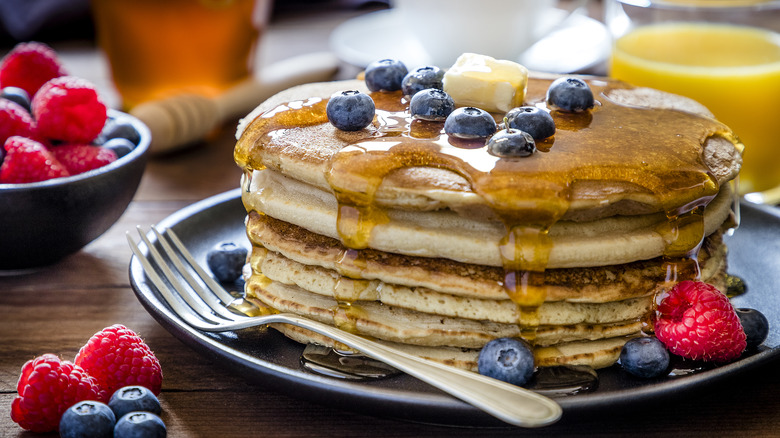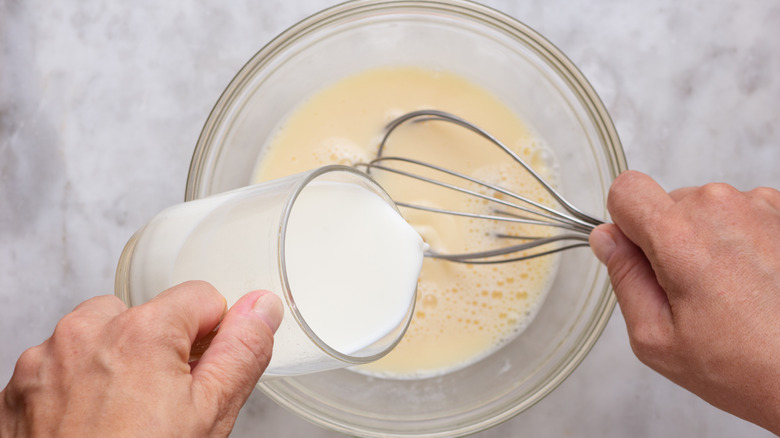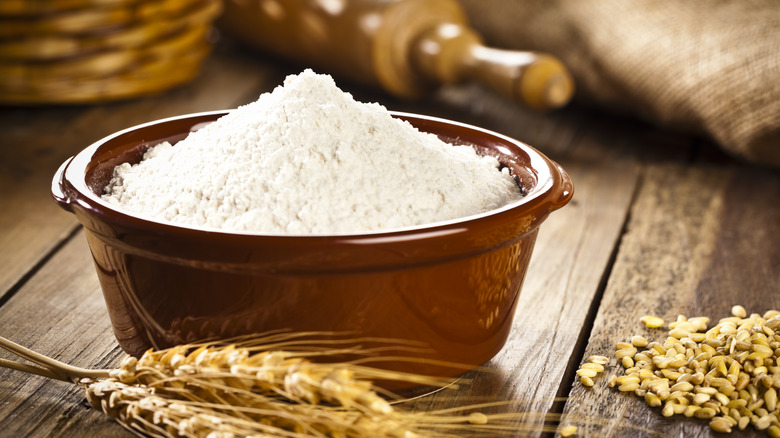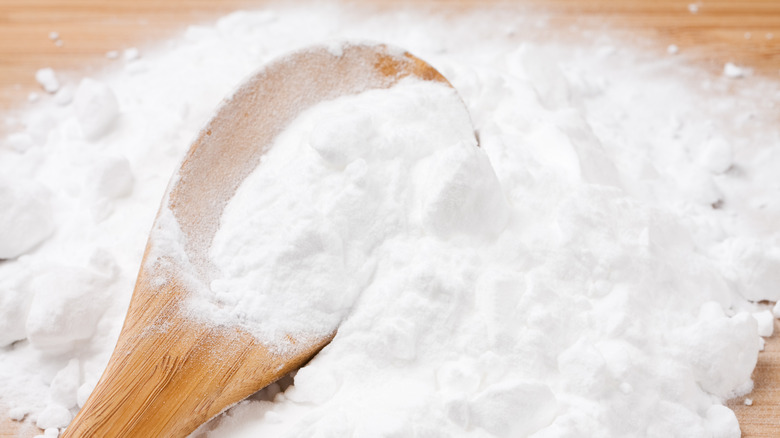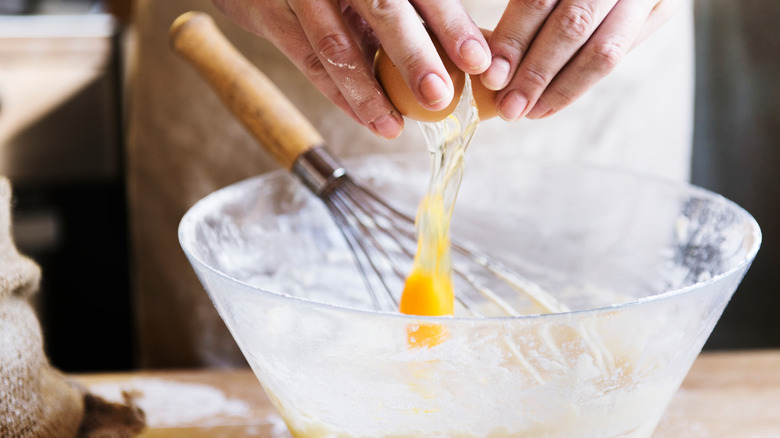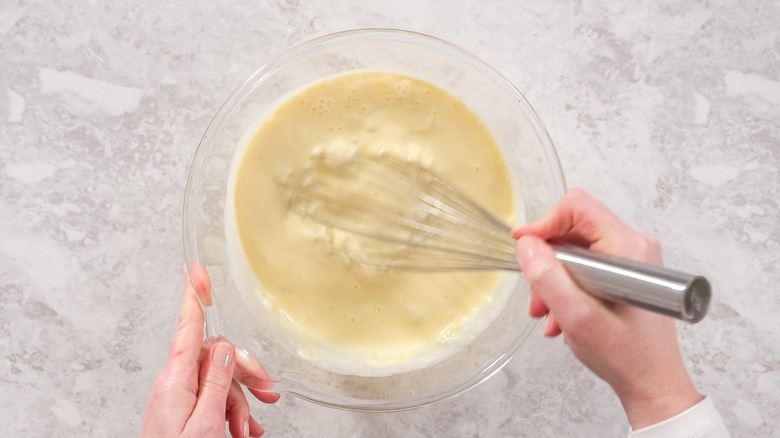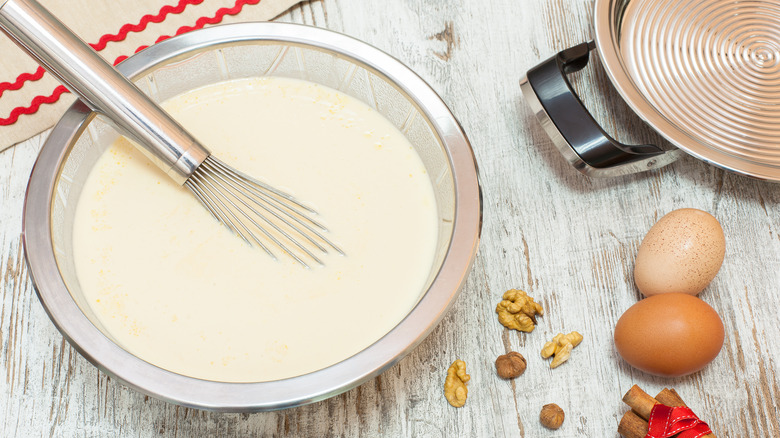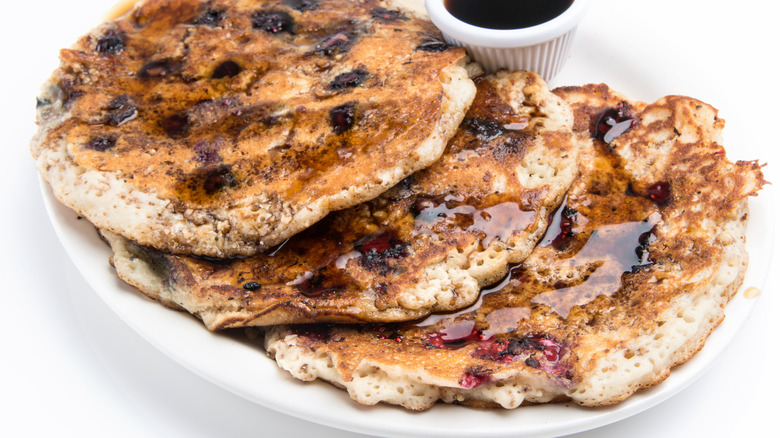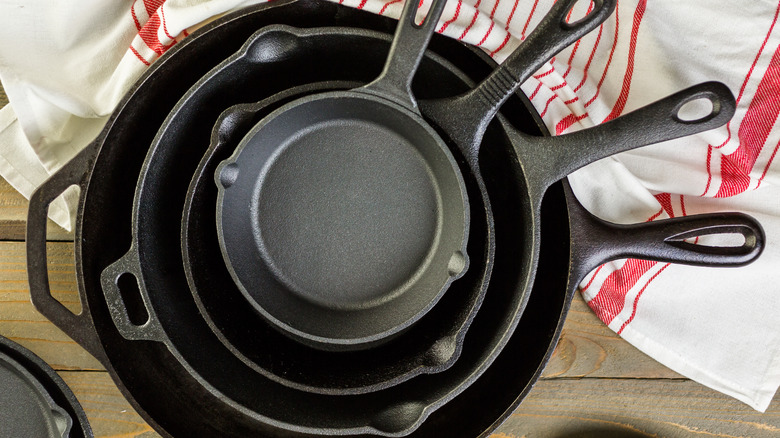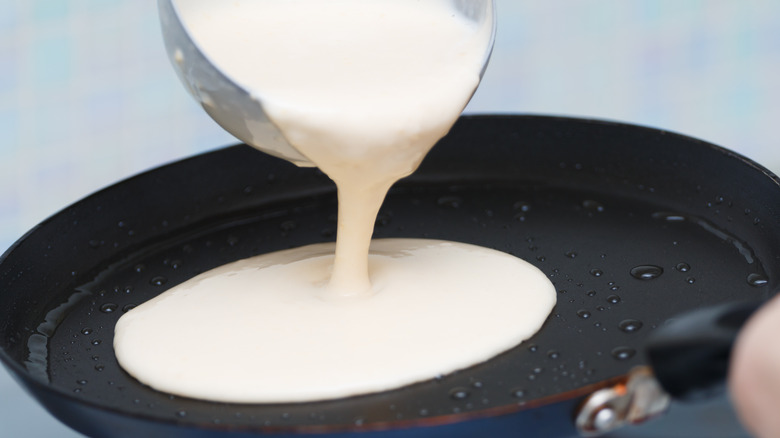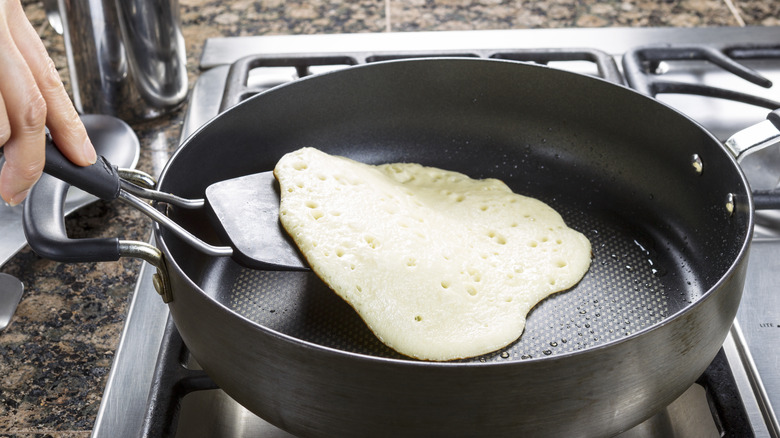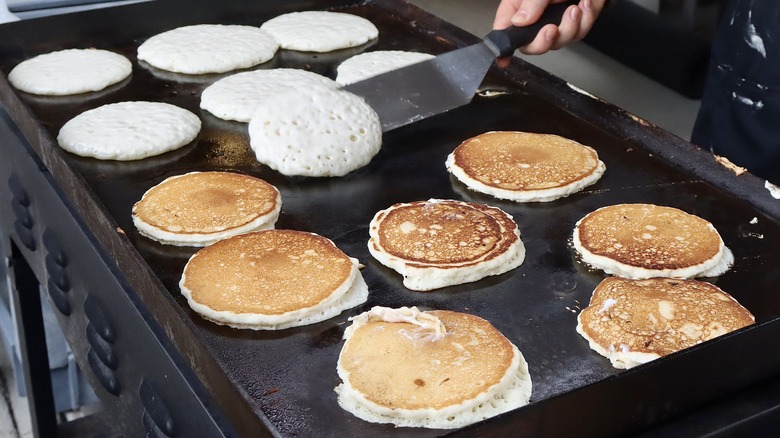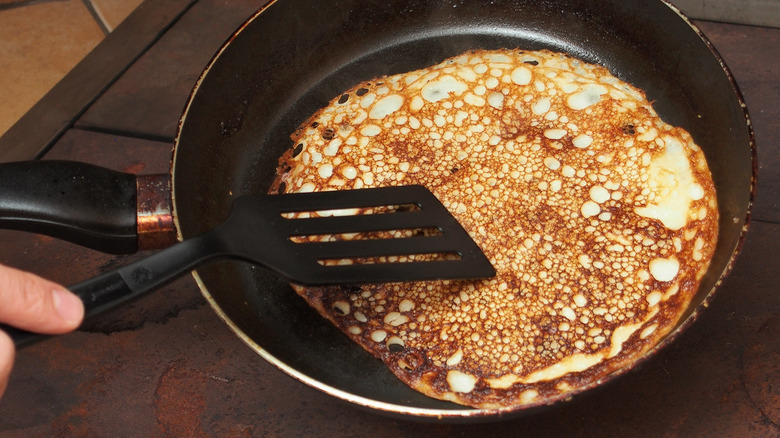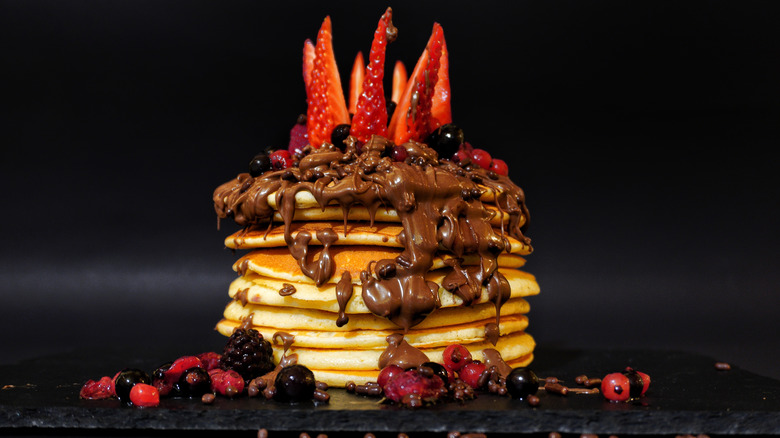Mistakes Everyone Makes With Pancakes
Hotcakes. Flapjacks. Johnnycakes. Short stacks. It doesn't matter what you call them; there's no denying that pancakes are one of the most delicious things you can eat in the morning (or any time of day or night). With a history that dates back thousands of years — to the ancient Greeks and likely much earlier — these flat, round cakes have been part of our culinary tradition longer than anyone really knows.
Made from a basic combination of flour, milk, eggs, and spices and cooked on a hot, flat surface, they couldn't be a more fundamental meal. Yet despite their simplicity, making the most delicious pancakes possible is also a true art form. It takes a bit of skill, finesse, and basic cooking knowledge — even if your batter comes from a box instead of a recipe passed down through the generations.
From grabbing the wrong ingredients when making your batter to poor cooking technique to an overall lack of patience, there are some common mistakes everyone makes with pancakes. Keep reading to discover how to avoid these common blunders and instead serve up the lightest, fluffiest pancakes around.
Not measuring ingredients properly
You can make a decent plate of pancakes using batter you prepare from a box. But why would you, especially when classic pancake batter is so easy to make? All you need is flour, milk, and an egg — stuff you likely have on hand. Remembering how much of each you need is also a breeze — just tell yourself 1:1:1. Classic pancake batter is simply a mixture of 1 cup of flour, 1 cup of milk, and 1 egg.
Of course, you can elevate the recipe from there by adding ingredients like baking powder, sugar, salt, and melted butter for more flavor or texture. But your pancake batter will be fine without those add-ins, too. Just be sure to measure out all your ingredients as precisely as possible. This isn't the kind of recipe you should eyeball or guess on.
Even a tiny bit too much flour can leave pancakes dense and heavy. Too little flour will leave your batter too thin, and your pancakes will spread more than you want on the griddle, becoming delicate and brittle. You get the same problem with too much milk. And too little dairy? Then your pancakes end up dry and lumpy. And nobody wants that.
Using the wrong flour
When it comes to a quality pancake batter, the type of flour you use makes all the difference. Flour determines just how fluffy your pancakes will be and also dictates their tenderness. In most instances, you'll make the best-tasting and most successful pancakes if you stick to all-purpose flour. This common variety of flour includes a blend of both harder and softer types of wheat, giving the flour greater versatility and providing a nice moderate level texture to cooked foods that is neither too firm nor too soft.
For lighter, fluffier pancakes, you might also use cake flour. This flour is more finely milled, creating smaller, finer flour particles ideal for making cakes and delicate breads. Whole wheat flour is another good option, especially if you like heartier, nuttier-tasting pancakes that also pack more "good-for-you" fiber.
On the flip side, steer clear of bread flour, which can yield denser, chewier pancakes. Self-rising flour is also not a great pick, especially if your batter recipe includes any baking powder or salt. Since these ingredients are also included in self-rising flour, your batter can end up with too many leavening agents. This creates pancakes that are spongy, that might rise quickly and then collapse, or that will simply cook unevenly in your skillet.
Using expired baking powder
Even if you're following the basic ratio of 1:1:1 of flour, eggs, and milk to make pancake batter, you might decide that you'd like your pancakes to be even fluffier than they already are. In that case, you can add 1 to 2 tablespoons of baking powder to your basic recipe. Baking powder is a leavening agent, which means that it helps products to rise and become lighter and airier as they cook.
Even though most of us have it in our kitchen, baking soda packs many secrets. For instance, you may not know that it's typically made up of a base, an acid salt, and a filler (traditionally sodium bicarbonate, aka baking soda; cream of tartar; and corn starch).
You also may not know that baking powder goes bad a lot more quickly than most of us might expect — once opened, its shelf-life is about six months. Unopened baking powder can last up to 18 months. If you don't know just how old the baking powder in your pantry is, mix a small amount in water. If it fizzes and bubbles, it's still good. However, if it does not react, has clumped or hardened, or is no longer pure white, it's time to pick up a new package.
Using expired baking powder in your pancakes won't make you sick, but it will result in pancakes that don't rise or that are flat and uber-dense — which defeats the purpose of using it in the first place.
Cracking eggs directly into your mixing bowl
Preparing an incredible bowl of pancake batter requires more than just selecting the best possible eggs. You also have to use them correctly once you pull them out of the fridge.
Eggs are an essential part of pancake batter, providing structure and flavor to the mixture. But as you crack your eggs for your pancakes, never break them directly over the bowl you are making your batter in. This is a massive mistake for many different reasons.
While it might seem like a time-saving measure, when you crack eggs directly into your batter, you risk shell fragments and shards ending up in the bowl. Cracking eggs directly into the bowl also puts you at risk of ruining your entire batch of pancakes, should that egg not be fresh or have some other sort of abnormality. When you crack an egg into a separate bowl first, you get an added level of quality control and can ensure your eggs are good before you put them in your batter.
Cracking eggs into a separate bowl also allows you to beat or whisk them before combining with your flour and milk. This provides more uniform mixing overall and can also help ensure your eggs are evenly distributed in your final batter mixture.
Overmixing the batter
To prepare a world-class bowl of pancake batter, you should always combine your wet and dry ingredients separately in individual bowls. Once you have your flour, leavening agents, and any spices you are including in your batter mixed well, gently pour in your wet ingredients. Then, use a spatula or large wooden spoon to gently fold the ingredients until they are well combined. If you notice small lumps or streaks of flour in the batter, that's okay. They should go away on their own. It's better to leave the lumps than risk overmixing your batter.
Overmixed pancake batter leads to tougher pancakes. It removes excess air pockets from the batter and makes it denser, so it doesn't rise as well during cooking. The overmixed batter also causes pancakes to cook unevenly and leads to flatter pancakes overall.
As you mix your batter, this is also the time you should monitor its consistency. It should be somewhat thick but still easily pourable. If the batter seems too thick or too thin, add flour or milk as needed to achieve just the right consistency you are after.
Not letting your batter rest before use
From pasta salads to freshly grilled steaks, allowing food time to rest before you serve it or prepare it is always a good idea. And the same principle holds true with pancake batter. Once you've prepared your ideal pancake batter mixture, avoid immediately making pancakes with it. Instead, give that batter time to rest; when you do, your typically "good" pancakes might just turn extraordinary.
Allowing pancake batter time to rest allows the liquid in your batter to fully hydrate the flour particles, making your batter smoother and reducing grittiness. The proteins in the flour will also become more tender and elastic when they have time to sit and absorb the moisture around them. This helps to make your pancake lighter and fluffier when it cooks. Finally, resting allows time for any leaving agents in your batter to do their thing, reducing gases and helping your batter rise and become airier, which again leads to added lightness and fluffiness in the cooking process.
Ideally, allow 20 to 30 minutes of resting time between making batter and cooking your first pancake. If you're short on time, even providing half that long will still yield noticeable improvements in the taste and texture of your pancakes.
Using batter that's too basic
Once you've mastered classic, old-school pancake batter made in that 1:1:1 ratio, it's time to season your batter for irresistible flavor. After all, there are an almost unlimited number of ways you can morph and transform that traditional batter mixture, making it sweeter, nuttier, more savory, tropical, or simply tastier overall.
For pancakes that verge on a wonderful dessert, try adding 1 to 2 teaspoons of vanilla extract, 1 teaspoon of ground cinnamon, or 2 to 3 tablespoons of honey or maple syrup to your standard egg, milk, and flour mixture. You can even add all three.
For nuttier pancakes, consider folding in ⅓ cup of your favorite chopped nuts (walnuts, pecans, and almonds are all ideal). You can also stir 1 to 2 tablespoons of peanut butter, almond butter, or hazelnut spread into your batter as well.
If you prefer a more savory pancake to pair with scrambled eggs or a side of sausage, fold shredded cheese, finely diced herbs like chives, parsley, or dill, or even 1 tablespoon of garlic powder, onion powder, or smoked paprika into your pancake batter.
And for fresh, tropical-tasting pancakes, fresh blueberries or slices of banana are a given. You could also fold the zest of a lemon or lime into your batter mixture or stir in 2 to 3 tablespoons of shredded coconut or ¼ cup of diced, crushed pineapple.
Using the wrong pan
From pork tenderloin with blackberry bourbon barbecue sauce to crispy-bottomed oyster mushroom steaks, there are so many incredible foods you can cook in a cast-iron skillet. And you can add your favorite style of sweet or savory pancakes to that list as well.
Cast iron skillets are an ideal way to cook pancakes for many reasons. They heat incredibly evenly, which helps you to make perfectly cooked pancakes without any hot spots. Cast iron pans are also durable and can last generations, provide a natural non-stick surface, retain heat well (which helps to keep pancakes warm after they're done cooking), and are easy to clean and maintain.
In addition to cast iron, non-stick skillets, griddle pans, carbon steel pans, ceramic-coated pans, and enameled pans are all great options for cooking out-of-this-world pancakes. Each distributes heat well, has excellent non-stick properties, and preheats well to provide an ideal pancake cooking environment.
On the other hand, thin aluminum pans, stainless steel pans without a nonstick coating, copper pans, grill pans and woks, and old or damaged non-stick pans are less ideal options. They are more prone to sticking, have limited cooking space, or just don't conduct heat well enough or heat evenly enough to make cooking pancakes a breeze. You might still be able to get the job done with one, but it will likely be a struggle.
Pouring too much batter on your pan
When the time comes to start making that delicious plate of wake-me-up pancakes, it can be easy to get a bit heavy-handed and pour more batter into your skillet than you intended. In addition to creating pancakes bigger than you might have been after, pouring too much batter in a skillet at once is a surefire way to burn or break your pancakes as they cook. Large pancakes are harder to flip, tend to be denser overall, and need extended cooking time, which increases their risk of charring.
Instead, always use a measuring cup to ensure a more consistent pancake size and to avoid over pouring. Measure ¼ to ⅓ cup of batter and pour it in a controlled manner in the center of your skillet, allowing it to spread naturally. Your skillet should already be warm — preheating the skillet before you add any batter helps to promote more even cooking and prevents sticking.
Finally, make sure you don't have too much oil in your pan before adding the batter. Aim for 1 to 2 tablespoons at the most, less if you are using a nonstick skillet. Too much oil makes pancakes greasy and soggy since the batter absorbs much of that oil during the cooking process. It also makes your pancake harder to flip and may cause it to cook more unevenly, depending on how the oil and batter are distributed in the pan.
Flipping your pancake too early
One of the biggest questions many of us face when making pancakes is, "When to flip?" The best indicator you can look for to signify that it's time to turn your pancake over is bubbles forming on the pancake's surface. These bubbles mean that the bottom side is cooking and the batter is settling. When the bubbles pop and leave some holes, that's your sign that the bottom is sufficiently cooked.
In addition to bubbles, you can also look at the edges of the pancake. When they appear set and are turning slightly golden, that's another indicator it's time to turn your pancake over.
Finally, if the pancake lifts easily off the skillet without sticking, that's one more cue that the bottom is done and it's ready to flip. As you turn your pancake over, move quickly and confidently — if you hesitate, the pancake is more likely to break. For the best-tasting pancake possible, try to flip your pancake only once during cooking. Turning your pancake more than once can lead to denseness and oiliness.
Although pancake cooking times are dependent on a number of variables, including the thickness of your batter, heat of your stove, and type of pan you are using, the process should be quick — one to two minutes for the first side and around half that time for the other. Keep a close eye on your pancakes to avoid unwanted scorching.
Overcrowding the pan
Whether you're cooking in a small skillet, a massive cast iron pan, or even on a restaurant-style grill, it's essential to not get too ambitious and try to cook too many pancakes simultaneously. While it might seem like a time-saving strategy, overcrowding the pan is one of the easiest ways to bring down the quality of your pancakes — and is a very common mistake many of us make.
Instead of saving time, overcrowding pancakes leads to uneven cooking. It makes turning pancakes over more challenging. And it can promote extra steam in your pan, making pancakes gummier and less crisp.
In a standard 10 to 12-inch skillet, aim to cook two to four medium-sized pancakes at a time. Your pancakes should be at least 1 inch away from one another — more if possible. If you hit another pancake while trying to turn one over, your pan is overcrowded. If you need an abundance of pancakes, plan on cooking them in batches instead of trying to prepare them all at once and reducing quality in the process.
Flattening your pancake with a spatula as it cooks
You may have heard that you should never press down on a hamburger patty or steak as it is cooking because this forces out juices and makes the meat tougher. Well, the same principle holds true with pancakes. Never press down on your pancake with a spatula in an attempt to speed up the cooking process.
Flattening your pancake as it cooks compresses the batter, pushing out air and reducing the volume of your pancake. This makes the pancake denser and less fluffy. The pressing motion also forces moisture out of your pancake, making pancakes drier.
Finally, flattening your pancake can make it cook more unevenly — and it makes the surface of the pancake look funky. To speed up the cooking process — instead of flattening your pancakes — use a thinner batter or make your cakes smaller so they cook more quickly.
Too many toppings
Finally, when it comes to mistakes we all make with pancakes, remember that there should be a limit to how many toppings you pile onto a plate of flapjacks before you dig in. Part of the true beauty of a pancake is the light, fluffy batter and the way it fries up to golden perfection. You get a subtle hint of nuttiness and the richness of the dairy in the batter, plus those crispy toasted edges.
The addition of some fresh fruit or butter or maple syrup can augment those flavors wonderfully, making the perfect pancake even more delicious and satisfying. But there should also be a limit to how many toppings you pile onto your stack of pancakes. When you top a pancake with berries, peanut butter sauce, a chocolate drizzle, whipped cream, and chopped nuts, your pancakes get soggy. All those toppings also overwhelm the taste of the pancake itself. Instead, the pancake's essence is lost amid a sea of competing flavors and textures, and you ultimately don't even know what you're eating.
So, pick your toppings wisely. Stick to just a couple, and make sure they are complementary. You've gone to all the trouble of making an incredible plate of pancakes — now be sure to let their flavor truly shine.

